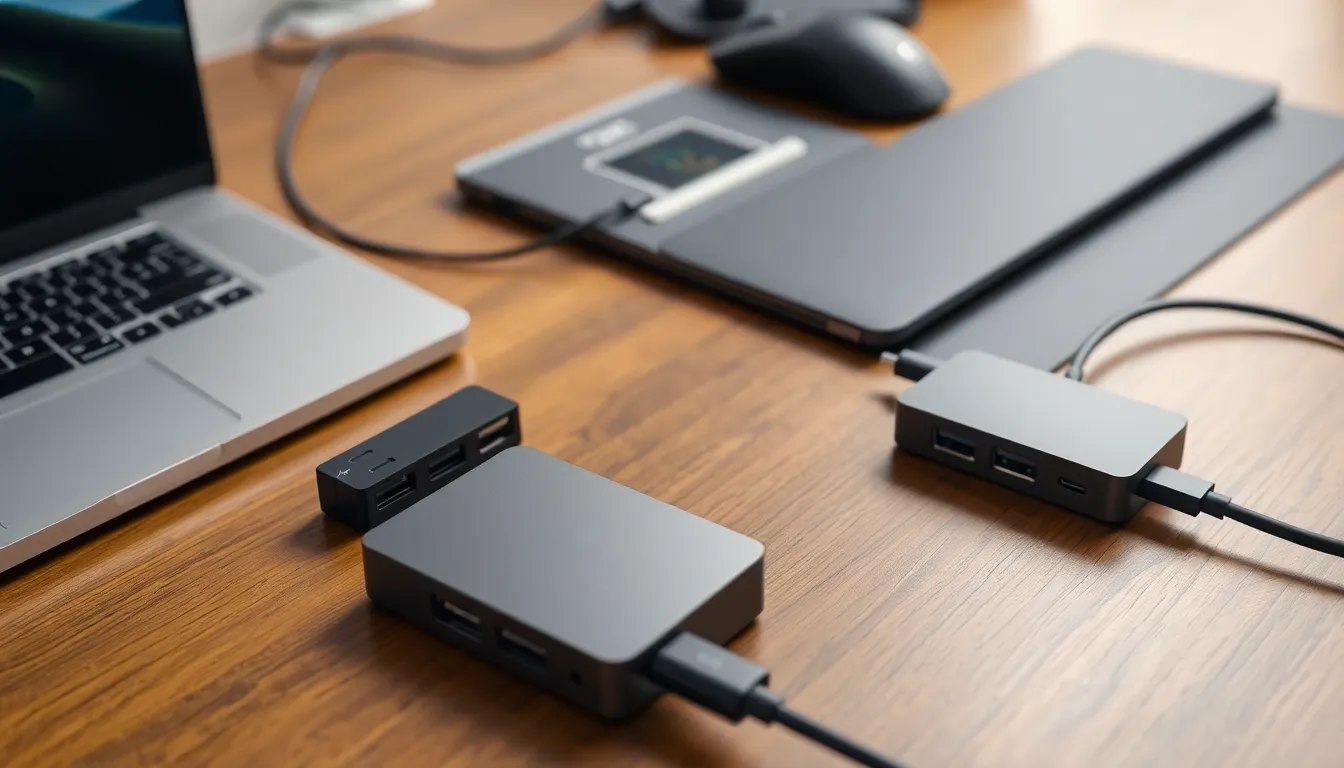In a world where devices multiply faster than rabbits, USB-C hubs have become the unsung heroes of connectivity. Gone are the days of juggling multiple cables and adapters like a circus performer. With a USB-C hub, users can seamlessly connect their laptops, tablets, and phones to a plethora of peripherals, all while maintaining a sleek and organized workspace.
Imagine transforming that cluttered desk into a minimalist’s dream, where one hub reigns supreme over a chaotic sea of wires. Whether it’s for charging, data transfer, or connecting to external displays, USB-C hubs are the ultimate solution. They’re not just gadgets; they’re the Swiss Army knives of the tech world, ready to tackle any challenge with a wink and a nod. So, let’s dive into the world of USB-C hubs and discover how they can simplify life, one connection at a time.
Table of Contents
ToggleOverview Of USB-C Hubs
USB-C hubs offer a streamlined solution for connecting multiple devices to a single port. They accommodate various peripherals such as external hard drives, monitors, and keyboards with ease. Port flexibility makes USB-C hubs essential for modern setups, allowing users to expand connectivity options without the bulk of multiple cables.
In terms of data transfer, USB-C hubs often support high-speed connections, which enhance productivity. For example, many hubs provide USB 3.0 or 3.1 ports, enabling rapid data exchange rates of up to 10 Gbps. When it comes to charging capabilities, some USB-C hubs deliver power delivery (PD), ensuring devices remain charged during intensive use.
Different types of USB-C hubs cater to specific needs. Multi-port adapters suit those who require several connections at once, while slim models appeal to users prioritizing portability. Some variants even feature HDMI ports for quick connection to external monitors, ensuring expanded display options for presentations.
Compatibility with various operating systems also contributes to their appeal. Most USB-C hubs support Windows, macOS, and Linux, ensuring broad usability across different platforms. Ease of use further enhances their attractiveness, as users can connect without complex installations.
Choosing the right USB-C hub depends on individual requirements. Identifying essential features, such as the number of ports or specific compatibility needs, streamlines the selection process. Overall, USB-C hubs simplify and enhance daily tech interactions, fostering an organized and efficient workspace.
Types Of USB-C Hubs

USB-C hubs come in various types, each designed to meet specific connectivity needs.
Powered USB-C Hubs
Powered USB-C hubs supply additional power to connected devices. Many feature an AC adapter, allowing users to charge laptops or power multiple peripherals simultaneously. These hubs can support intensive tasks, such as video editing or gaming, requiring more power. Users commonly find features like fast-charging capability and multiple ports to connect peripherals seamlessly. Providing both data transfer and power delivery, these hubs maintain device performance while reducing cable clutter.
Passive USB-C Hubs
Passive USB-C hubs operate without an external power source. Connection to devices is straightforward and relies solely on the power from the USB-C port. These hubs primarily serve basic functions like connecting mice, keyboards, and external drives, offering sufficient support for everyday tasks. Typically, they contain multiple USB ports for added flexibility. Users appreciate their lightweight design and portability, making them suitable for on-the-go use. Ideal for light workloads, these hubs offer convenience without the complexity of powered models.
Key Features To Consider
When selecting a USB-C hub, several key features influence performance and usability. These attributes ensure the hub meets user needs in diverse environments.
Port Variety
A wide variety of ports expands functionality. USB-C hubs typically include USB-A, HDMI, and Ethernet ports. Many hubs offer multiple USB-A ports for connecting peripherals like mice or keyboards. Having HDMI ports enables connections to external displays, enhancing productivity during presentations or creative work. Ethernet ports provide stable internet connections, beneficial in settings with unreliable Wi-Fi. Selecting a hub with diverse port options ensures compatibility with various devices.
Data Transfer Speeds
Data transfer speeds significantly impact efficiency in tasks. USB-C hubs support various standards, with USB 3.0 and 3.1 being the most prevalent. Hubs equipped with USB 3.0 ports deliver speeds up to 5 Gbps, while USB 3.1 ports reach 10 Gbps or higher. Such rapid transfer speeds facilitate quick file sharing and improved workflow, especially for users transferring large files frequently. Prioritizing hubs with higher data transfer rates enhances overall productivity for demanding applications.
Compatibility
Compatibility plays a crucial role in the selection process. USB-C hubs work seamlessly with major operating systems such as Windows, macOS, and Linux. Many hubs support both modern and legacy devices, making them versatile for various setups. Ensuring the hub is compatible with specific devices avoids frustration during setup. Users benefit from hassle-free connections that require no complex installations. Focusing on compatibility promotes a smooth integration into existing tech ecosystems.
Top USB-C Hubs On The Market
USB-C hubs provide a seamless way to connect multiple devices while optimizing workflow. Here’s a look at some top choices available today.
Budget-Friendly Options
Anker’s 4-Port USB-C Hub stands out as an affordable option, offering multiple USB-A ports and high-speed data transfer rates up to 5 Gbps. Aukey also features a compact hub with HDMI output, suitable for connecting to an external monitor. Users appreciate its lightweight design, making it easy to carry. HooToo’s USB-C hub provides excellent compatibility with various devices while maintaining a low price point. Those looking for value without sacrificing quality will find these budget-friendly choices meet their basic connectivity needs.
High-End Choices
CalDigit’s TS3 Plus remains a prominent choice in the high-end category, boasting 15 ports for extensive connectivity options, including 4K video output and high-speed data transfer at 10 Gbps. HyperDrive offers a versatile model tailored for MacBook users, integrating multiple ports into a sleek design that enhances aesthetics and functionality. Belkin’s Thunderbolt 3 Dock Pro provides impressive power delivery, paired with fast data transfer capabilities. Professionals engaged in demanding tasks benefit greatly from these hubs, ensuring they have the full range of needed connectivity while minimizing workspace clutter.
USB-C hubs have become essential tools for anyone looking to streamline their tech experience. They simplify connectivity while enhancing productivity by allowing multiple devices to connect through a single port. Whether it’s for work or leisure the right hub can transform a cluttered workspace into an organized haven.
With a variety of options available users can easily find a hub that fits their specific needs. From budget-friendly models to high-end solutions these hubs cater to diverse requirements and ensure seamless integration into existing setups. Embracing the versatility of USB-C hubs not only improves efficiency but also elevates the overall user experience in today’s fast-paced digital world.




